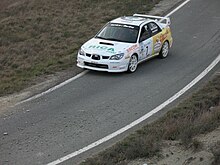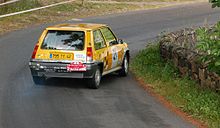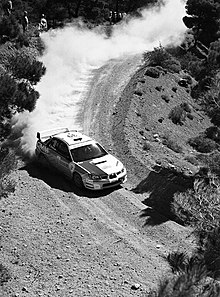Group N


In relation to internationalmotorsportgoverned by theFIA,Group Nrefers to regulations providing "standard" large-scale series production vehicles for competition. They are limited in terms of modifications permitted to the standard specification by the manufacturer making them a cost effective method of production vehicle motorsport. Often referred to as the "showroom class", Group N contrasts withGroup Awhich has greater freedom to modify and tune the cars to be more suitable to racing. Both groups may have the same or similar models homologated by a manufacturer.
Group N was introduced by the FIA in 1982 to replace the outgoingGroup 1as "standard touring cars". At this time there were not specific formulae for production racing cars in competition. TheWorld Rally Championship(WRC), for example, only permitted groups A, B and N cars to compete (Group B was banned from 1987). It was not until 1997 that the World Rally Car formula was introduced and other specific formulae were introduced in later years. Both group N and A, and the details of their differences, are described in the FIAs International Sporting Code and several of its appendices.[1][2][3][4][5]
To qualify forhomologationa minimum of 2500 cars of the competing model have to be produced in the 12 months prior to homologation. The homologation period runs for seven years after every consecutive year of qualifying production of the model, with production of the model considered stopped when less than 10% (250) are made in one year. Before 1993 the production requirement was 5000.[6]
Circuit racing
[edit]
Touring cars
[edit]While Group A became the standard category for international leveltouring car racing,Group N found a home as a more economic class in national level touring car racing. In many countries, there would often be two touring car championships, one for Group A and one for Group N. The category had some brief success with the demise of theSupertouringclass in the late 1990s, when a few national regulations were relaxed to allow a greater number of modifications, in the guise ofSuper Production.
Endurance racing
[edit]The category is still used in circuit racing all over the world, especially in Japan, which has the long runningSuper Taikyu(スーパー nại cửu,Super Taikyu,translated as 'Super Endurance'),as well as in the ItalianETCSendurance series run by Peroni Promotion, but was once again relegated to a secondary status with the introduction ofSuper 2000,the class of cars currently run in theWorld Touring Car Championship.
Rallying
[edit]

Inrallying,Group N could be entered into the open WRC driver and co-driver championships and the manufacturers championship until 1997. Due to the nature of Group A cars being more suitable and tuned race cars they tended to dominate results. A Group N car has won a WRC rally once, a Renault 5 driven by Alain Oreille at the Rallye Côte d'Ivoire in 1989.

Group N had four classes based on engine displacement cylinder capacity. N1 was for cars up to 1400 cc, N2 was 1401-1600 cc, N3 was 1601-2000 cc and N4 was over 2000cc. Cars fitted with a turbo had their displacement capacity multiplied by 1.7 to determine class. Only N4 class cars remain homologated as of November 2021 as the other classes had been phased out in FIA competition.[7]
TheProduction World Rally Championshipwas run under Group N rules between 1987 and 2012. Popular cars used were often based onturbocharged,four wheel driveversions of standard consumer production cars such as theSubaru Impreza WRXand theMitsubishi Lancer Evolution,although a wide range of vehicles were homologated by the FIA including small two wheel drive hatchbacks.
Group N regulations were intended to be phased out from rally competition in 2013.[8]With the introduction ofGroup Rthe FIA created theR4 classintending it to be the "new Group N" and existing N4 cars could also be re-homologated in the new group. This was abandoned in 2015 and a new sporting class, NR4, was added where four-wheel drive Group N cars over 2000 cc could continue to compete within the Group R format. R4 cars were then not allowed in FIA-sanctioned rallies in Europe, but since R4 was basically a transition group for old homologated Group N, many of those could be run in NR4.[9]
In the reform of the support championships in the2013 season,the Group N4's cars were some of the eligible cars in WRC-2, considering their competitiveness to the other types likeSuper 2000andGroup Rcars in the category, there was also a FIA Production Car Cup among N4 cars in WRC-2. Group N cars have not been eligible for WRC rallies since 2019 but the FIA regional rally championships continue to allow N4 cars.
Away from FIA sanctioned events, many rallies at national level are run under Group N. Some local variants of Group N have been created to allow other marques to compete where Group N is the national formula.
Allowed modifications
[edit]The range of modifications allowed was quite narrow - few mechanical engine modifications were allowed (save for lightening within set limits and baffled sumps) although the choice ofECUwas free, and this could liberate some extra power itself, and most of the modifications allowed were to promote longevity rather than increased performance, although the boundaries of these two areas were blurring towards the end of the group's lifespan. Furthermore, cars withforced inductionengines were fitted with a restrictor in front of the charger to limit power.[10]
Originally, Group N meant that all the interior trim had to be present (including the rear seat), but it later changed to allow removal of the trim aside from the dashboard and replacement of the door trim. The springs and dampers were free, as are the internals of the gearbox and the final-drive ratio, providing that the homologated gear ratios and gear change pattern were respected. This allowed the use of dog-engagement gearboxes, providing quicker gearchanges and longer gearbox life. There was provision for strengthening of the suspension components and bodyshell, provided this didn't alter the operating principle.[11]
References
[edit]- ^"INTERNATIONAL SPORTING CODE"(PDF).
- ^"Classification and Definitions"(PDF).
- ^"General Prescriptions for Cars of Group N, A (and Extensions) and R-GT"(PDF).
- ^"Specific Regulations for Production Cars (Group N)"(PDF).
- ^"Specific Regulations for Touring Cars (Group A)"(PDF).
- ^"FIA Yearbook of Automotive Sport 1982"(PDF).
- ^"HOMOLOGATIONS LIST – 2021 Group N"(PDF).
- ^"Specific regulations for cars in Groups R"(PDF).FIA.com.Fédération Internationale de l'Automobile.19 May 2012.Retrieved13 October2014.
- ^"FIA WRC PRODUCTION RALLYING CLASS CHANGES IN 2015".dirtyimpreza.com.Archived fromthe originalon 2015-06-19.Retrieved2015-06-18.
- ^Subaru parts lists for the Group N base car (PDF)Archived2009-12-29 at theWayback Machine
- ^Group N Cars as described in rallycars.com
